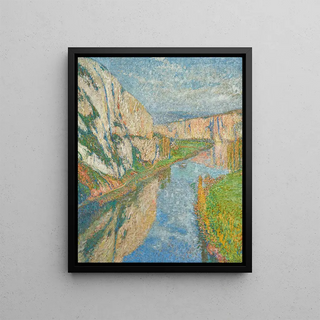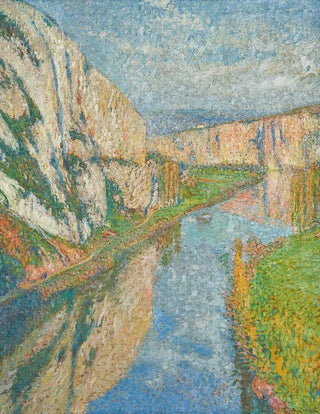Art print | The Lot at the foot of the cliffs of Saint-Cirq-Lapopie - Henri Martin


View from behind

Frame (optional)
Henri Martin’s art print of Le Lot aux pieds des falaises de Saint-Cirq-Lapopie is an invitation to immerse oneself in a landscape that is both serene and vibrant. Painted at the end of the nineteenth century, this piece illustrates the timeless beauty of the French countryside, capturing light and colors in a way that feels almost magical. As you contemplate this bucolic scene, you are transported to a world where tranquility reigns, where lush valleys blend with majestic cliffs, and where the Lot river meanders gracefully. This art print is not merely a panorama; it evokes deep emotions and a connection with the landscape, paying homage to the richness of the Saint-Cirq-Lapopie region.
Style and uniqueness of the work
Henri Martin stands out for his impressionist approach, blending vibrant brushstrokes and play of light that breathe life into his compositions. In Le Lot aux pieds des falaises de Saint-Cirq-Lapopie, he uses bold brushstrokes to create an almost tangible atmosphere. Shades of green and blue blend harmoniously, while the sunlight’s reflections on the water add an almost ethereal dimension to the scene. The composition is carefully balanced, with imposing cliffs rising in the background, framing the river that flows peacefully. This art print is distinguished by its ability to capture the essence of a fleeting moment, where nature seems suspended in time, inviting the viewer to savor the beauty of the present instant.
The artist and his influence
Henri Martin, born in 1860, is often associated with the Post-Impressionist movement, a current that successfully combined the Impressionist legacy with stylistic innovations. Influenced by masters such as Claude Monet and Paul Cézanne, Martin developed a personal style characterized by luminous palettes and dynamic compositions. His work is marked by a deep admiration for nature, and he often chose to depict landscapes of rural France. Le Lot aux pieds des falaises de Saint-Cirq-Lapopie bears witness to

Matte finish

View from behind

Frame (optional)
Henri Martin’s art print of Le Lot aux pieds des falaises de Saint-Cirq-Lapopie is an invitation to immerse oneself in a landscape that is both serene and vibrant. Painted at the end of the nineteenth century, this piece illustrates the timeless beauty of the French countryside, capturing light and colors in a way that feels almost magical. As you contemplate this bucolic scene, you are transported to a world where tranquility reigns, where lush valleys blend with majestic cliffs, and where the Lot river meanders gracefully. This art print is not merely a panorama; it evokes deep emotions and a connection with the landscape, paying homage to the richness of the Saint-Cirq-Lapopie region.
Style and uniqueness of the work
Henri Martin stands out for his impressionist approach, blending vibrant brushstrokes and play of light that breathe life into his compositions. In Le Lot aux pieds des falaises de Saint-Cirq-Lapopie, he uses bold brushstrokes to create an almost tangible atmosphere. Shades of green and blue blend harmoniously, while the sunlight’s reflections on the water add an almost ethereal dimension to the scene. The composition is carefully balanced, with imposing cliffs rising in the background, framing the river that flows peacefully. This art print is distinguished by its ability to capture the essence of a fleeting moment, where nature seems suspended in time, inviting the viewer to savor the beauty of the present instant.
The artist and his influence
Henri Martin, born in 1860, is often associated with the Post-Impressionist movement, a current that successfully combined the Impressionist legacy with stylistic innovations. Influenced by masters such as Claude Monet and Paul Cézanne, Martin developed a personal style characterized by luminous palettes and dynamic compositions. His work is marked by a deep admiration for nature, and he often chose to depict landscapes of rural France. Le Lot aux pieds des falaises de Saint-Cirq-Lapopie bears witness to






